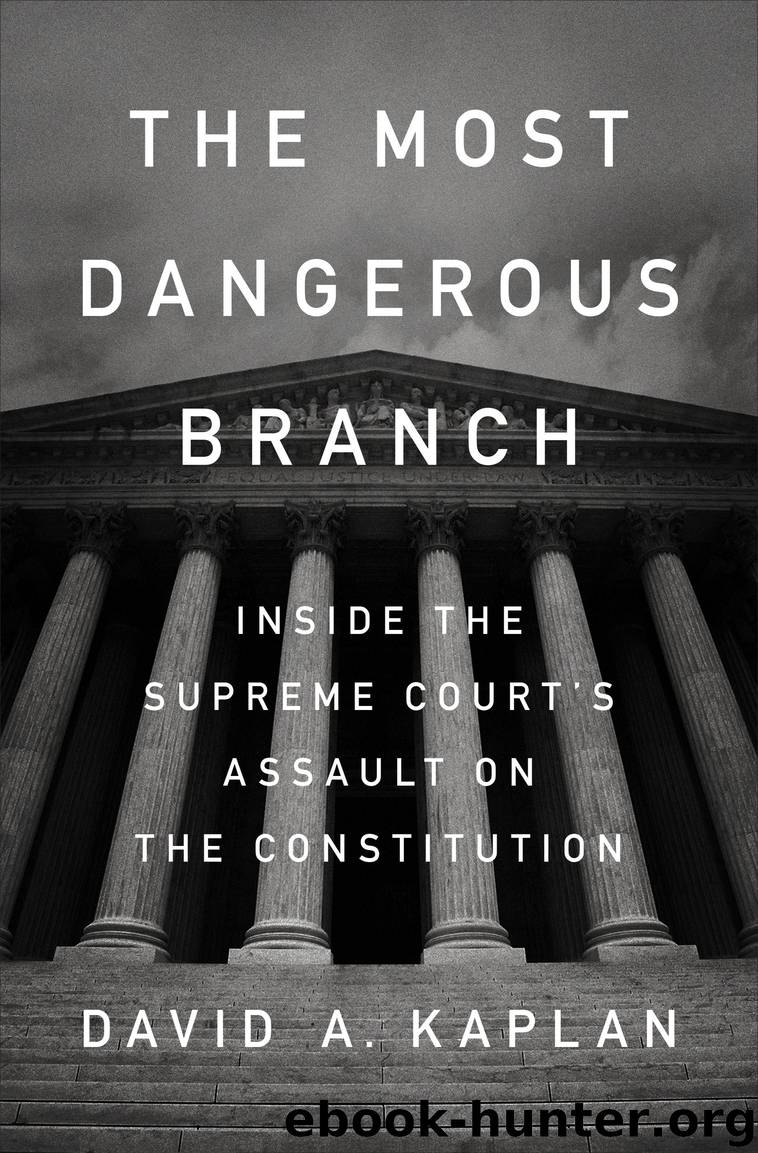The Most Dangerous Branch by David A. Kaplan

Author:David A. Kaplan
Language: eng
Format: epub
Publisher: Crown/Archetype
Published: 2018-09-03T16:00:00+00:00
* * *
—
A week later, the Gore legal team filed suit in state court to stop Harris from certifying the election returns until manual recounts had been completed in the four counties that Gore had selected. Democrat-backed litigation on recounts followed elsewhere in the state. The Florida Supreme Court quickly stepped in to block Harris and unanimously ordered her to include the results of recounts in her tally. Bush appealed to the U.S. Supreme Court. One of his lawyers, George Terwilliger, well described why. “The first thing they teach in law school is, ‘Give me the court, and I’ll give you the ruling.’ ” Terwilliger called the Florida Supreme Court “result-oriented, philosophically liberal and politically Democratic.” He could have added that Gore’s legal team considered the U.S. Supreme Court result-oriented, philosophically conservative and politically Republican.
Few scholars expected the justices to go anywhere near a state election dispute, even if it involved the presidency. Norms of judicial humility had changed, but the experts agreed it would be institutional hubris to grant cert. Ginsburg told clerks the Court wouldn’t touch the election “with a 10-foot pole”—right before the Court took the case. One of Bush’s lawyers, a top appellate practitioner in Washington who had previously served in two Republican administrations, thought otherwise. He flew down to Florida’s capital, Tallahassee, to offer advice. His name was John Roberts, and he turned out to be right. To the horror of Justices Ginsburg, Stevens, Souter and Breyer—who became the dissenters in Bush v. Gore—the Court on November 24 accepted this initial appeal out of Florida, called Bush v. Palm Beach County Canvassing Board. It was the first in a cascade of blunders by the justices.
Court arguments normally are scheduled months in advance, giving parties a chance to brief the issues fully and offering justices the opportunity to size up the issues. However, for this case, argument was set for only a week hence—an expedited calendar used only in extraordinary situations like the Pentagon Papers Case in 1971 or the Nixon Tapes Case in 1974. An unresolved presidential election necessitated haste, but with haste came the amplified possibility of sloppy analysis.
Bush wanted the Court to hear his claim about equal protection—that varying recounting standards violated the Fourteenth Amendment because voters were denied an equal voice. But the justices declined. Not only was it premature because Middlebrooks’s ruling was still pending before an appeals court, but such a question would also open a Pandora’s box. There were 3,141 counties in the United States. Most contained multiple municipalities, each of which might have separate voting precincts. All used different machines, ballot designs, instructions and personnel. Lines could be short in some neighborhoods, around the block in others. Polls were open for 12 hours in some places, 15 in the next. Many of the disparities disproportionately affected African Americans. Such impact had always been a benchmark of equal protection jurisprudence. African Americans tended to live in poorer areas, which had less reliable voting equipment. In a close election, variations related to race might far exceed whatever nonracial differences might be revealed in a recount.
Download
This site does not store any files on its server. We only index and link to content provided by other sites. Please contact the content providers to delete copyright contents if any and email us, we'll remove relevant links or contents immediately.
Objection! by Nancy Grace(1741)
Apeirogon by Colum McCann(1653)
Anatomy of Injustice by Raymond Bonner(1622)
That Every Man Be Armed by Stephen P. Halbrook(1549)
Civil Procedure (Aspen Casebooks) by Stephen C. Yeazell(1512)
The Vaccine Court by Rohde Wayne(1474)
Injustices by Ian Millhiser(1463)
Storytelling for Lawyers by Meyer Philip(1424)
A Practical Guide to International Arbitration in London by Hilary Heilbron(1396)
Restitution by Restitution(1394)
Coercing Virtue by Robert H. Bork(1325)
Broken Scales by Joel Cohen(1315)
Tangled Webs: How False Statements Are Undermining America: From Martha Stewart to Bernie Madoff by James B. Stewart(1299)
The Tools of Argument: How the Best Lawyers Think, Argue, and Win by Joel Trachtman(1288)
A Matter of Interpretation by Antonin Scalia(1268)
INDEFENSIBLE: One Lawyer's Journey Into the Inferno of American Justice by Feige David(1252)
American Tragedy by Lawrence Schiller & James Willwerth(1247)
A Religious Orgy in Tennessee by H.L. Mencken(1219)
Tangled Webs by James B. Stewart(1213)
